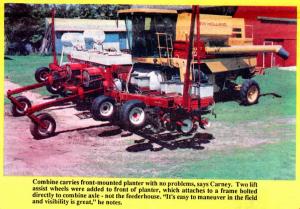1991 - Volume #15, Issue #4, Page #01
[ Sample Stories From This Issue | List of All Stories In This Issue | Print this story
| Read this issue]
He Uses His Combine To Plant Corn
 |
 |
 |
Carney used his "combine-planter" last spring to plant 900 acres of corn and soybeans and says it did an outstanding job. This fall he'll harvest with the combine for the first time.
"I got the idea because I needed a bigger planter and didn't want to spend the money for a tractor to pull it," says Carney, who built the "combine-planter" with the help of brother-in-law Clayton Black. "I had been using an IH Early Riser 6-row no-till air planter and traded it in for the 198712-row semi-mount. A new tractor big enough to pull it would have cost at least $50,000. My new combine cost about $130,000 so I decided to make it do double duty. I spent about $2,500 to modify it to carry the planter. I was familiar with both the planter and combine, but it took quite a bit of head-scratching to figure out how to match them up. However, people who see it are surprised at how simple it is. I didn't have to modify the planter much or do any welding on it."
Carney removed the combine's head and feeder-house, then mounted a 10-ft. long, 7 by 7-in. toolbar across the front of the combine, solidly anchoring it to the front axle and feederhouse mounting brackets. He then cut the lift assist wheels off the rear of the planter and bolted the lift arms that originally attached to the lift wheels to the new combine toolbar. He mounted a new pair of lift assist wheel arms on front of the planter. A 200-gal. spray tank tucked back under the combine cab carries herbicides.
"I originally planned to 3-pt. mount the planter to the feederhouse, but it would have been a complicated job and I didn't want to damage the feederhouse by carrying all that weight on it," says Carney. "The axle-mounted frame makes it nice and simple. I found that it really doesn't make any difference to the planter whether it's pushed or pulled because it did a good job of planting seeds accurately at a consistent depth. No-till coulters and Acra Plant trash whippers are mounted in front of each row unit. I have a great view of the planter and can see it almost as well at night as during the day.
"The combine's 185-hp 6-cylinder diesel engine has twice as much power as I need. The engine was designed for maximum load at full rpm's and tended to 'lurch' too much. I turned the governor down so it would run smoother at lower rpm's. The 24-in. wide combine tires fit easily between the planter's 30-in. rows and cause no more soil compaction than tractor tires would. I didn't have to change tire spacing at all. The planter weighs about 12,000 lbs., but most of its weight is carried in the field by the planter row units and by four gauge wheels so there's very little weight on the combine's front axle or on the frame. The combine actually carries less weight up front than it was designed to handle which makes it easy to steer and maneuver in wet conditions. Even in transport the planter weighs only about 4,000 more pounds than the feeder-house and header, and much of that weight is supported by the front lift assist wheels. It handles great on the highway."
According to Carney, putting more hours on the combine's drive train and engine shouldn't be a problem because they're designed to last longer than the rest of the combine anyway. He installed a separate hour meter gauge on the threshing cylinder so that when he trades the combine in he can prove how many hours it was used for harvest. "Even with the planter mounted on the combine I think the manufacturer's warranty on the engine is still good, but if the transmission ever fails I doubt that the warranty would cover it," says Carney. "If the combine did break down during planting it wouldn't take long to remove the planter to pull it with a tractor. To move it around when it's not mounted on the combine, I just move the front lift assist wheels to the rear of the planter and hook a tractor up to the planter's 3-pt. hitch."

Click here to download page story appeared in.

Click here to read entire issue
To read the rest of this story, download this issue below or click here to register with your account number.




